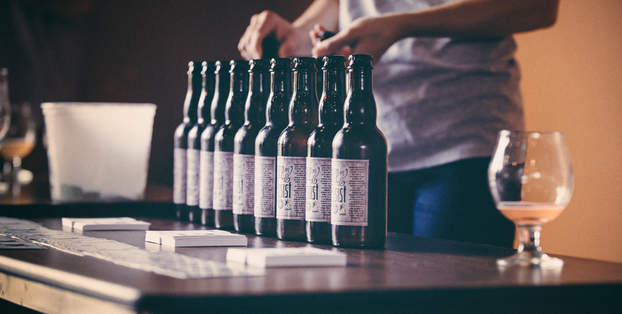
Bottle conditioning makes for a great specialty release, reminding customers that beer is a living, breathing organic thing. Among our Five Beers to Know last week was the bottle conditioned Really Really Ridiculously Good Tasting a farmhouse ale from Denver-based Call to Arms Brewing Co. The beer’s primary fermentation involved a traditional French Saison yeast, followed by an addition of Brett Claussennii to produce a slight barnyard funk. The beer is then packaged with champagne yeast and bottle conditioned, which results in a farmhouse ale reminiscent of a delicate Sauvignon Blanc aged in oak.
“It’s a blend of old school tradition with our modern day-to-day brewing techniques,” said Chris Bell of Call to Arms. “You’re adding 100 percent fermentable sugar to a beverage that is going to condition warm. If there is anything else in the bottle it will also grow, so you have to be extremely careful and intentional throughout the process.”
Since Call to Arms is all about bottle conditioning, we followed up with them for some tips on how to get it right. Below are five bottle conditioning tips from Jon Cross, coowner and head brewer at Call to Arms Brewing.
1. Sanitation — Any time you’re reintroducing fermentable sugar to a finished beer, it opens up the possibility of infection, either from wild yeast or bacteria. Nothing is worse than opening your prized bottles to find they’ve gone sour or funky. Everything used during this process must be obsessively cleaned and sanitized.
2. Proper mixing — Adding a dry sugar product to beer can be tricky if done the wrong way. One best practice is to add the sugar to a sanitary vessel with piping hot water. We shoot for 180 degree F on the water to dissolve the sugar and effectively pasteurize it. From there you have to be 100 percent sure the solution is homogeneous and the sugar completely dissolved before adding it to the beer. From there, mix, mix and mix the beer/sugar solution! However this process works best for you depends on the equipment available but overkill on the mixing is a good thing.
3. Use healthy yeast — Often times the yeast after fermentation is adequate for bottle conditioning, but it always helps to take a viability before proceeding. If you don’t have a microscope and stain for viabilities, we suggest using fresh, neutral yeast to ensure that the sugar gets consumed.
4) Consistent storage conditions — Bottle conditioning adds a number of variables to an already complicated process. The best way to ensure a consistent product is to keep the beer in a warm, stable environment ( 65 to 70 degrees F) and out of direct light. Carelessly placing the beer near sources of excess heat or cold can destroy any consistency from bottle to bottle. Additionally, if you smashed that beer full of hops, any light exposure will give you a wonderfully skunky end product. Gross.
5) Did we mention sanitation!? — Keep it clean. Keep it happy. Y’all got this!





Leave a Reply
You must be logged in to post a comment.